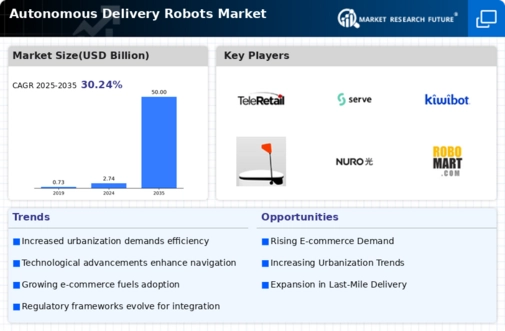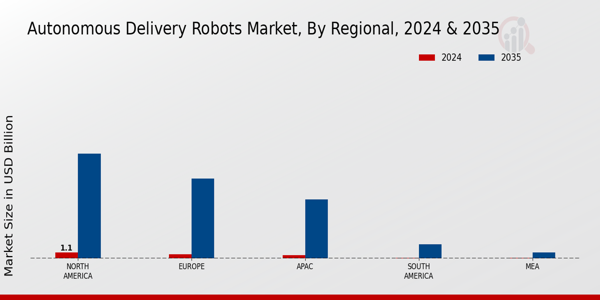Market Growth Projections
The Global Autonomous Delivery Robots Market Industry is poised for remarkable growth, with projections indicating a market value of 50 USD Billion by 2035. This growth trajectory is supported by a compound annual growth rate (CAGR) of 30.21% from 2025 to 2035, reflecting the increasing adoption of autonomous delivery solutions across various sectors. The market's expansion is driven by factors such as technological advancements, rising demand for contactless delivery, and supportive government regulations. As businesses continue to invest in innovative delivery methods, the market is likely to witness transformative changes, reshaping the logistics landscape on a global scale.
Government Support and Regulation
Government support and regulatory frameworks are crucial drivers of the Global Autonomous Delivery Robots Market Industry. Many governments are recognizing the potential of autonomous delivery solutions to enhance logistics efficiency and reduce traffic congestion. Initiatives aimed at fostering innovation, such as grants and subsidies for research and development, are becoming more prevalent. Furthermore, regulatory bodies are establishing guidelines to ensure the safe operation of delivery robots in urban environments. This supportive landscape encourages investment and innovation, positioning the market for sustained growth as regulatory clarity emerges, thus facilitating the broader adoption of autonomous delivery technologies.
Urbanization and E-commerce Growth
The rapid pace of urbanization and the concurrent growth of e-commerce significantly influence the Global Autonomous Delivery Robots Market Industry. As urban populations expand, the demand for efficient delivery solutions intensifies. E-commerce giants are increasingly relying on autonomous delivery robots to meet consumer expectations for fast and reliable service. This trend is underscored by the anticipated compound annual growth rate (CAGR) of 30.21% from 2025 to 2035, indicating a robust market trajectory. The integration of autonomous delivery systems allows businesses to streamline operations and cater to the evolving needs of urban consumers, thereby propelling the market forward.
Rising Demand for Contactless Delivery
The Global Autonomous Delivery Robots Market Industry experiences a surge in demand for contactless delivery solutions. As consumers increasingly prefer minimal human interaction, businesses are adapting by integrating autonomous delivery robots into their logistics. This shift is evidenced by the projected market value of 2.74 USD Billion in 2024, reflecting a growing acceptance of technology in everyday transactions. Companies like Amazon and Walmart are investing in autonomous delivery systems to enhance customer satisfaction and operational efficiency. This trend indicates a significant transformation in consumer behavior, which is likely to drive further growth in the Global Autonomous Delivery Robots Market Industry.
Technological Advancements in Robotics
Technological advancements play a pivotal role in the expansion of the Global Autonomous Delivery Robots Market Industry. Innovations in artificial intelligence, machine learning, and sensor technology enable robots to navigate complex environments with greater precision. For instance, companies are developing robots equipped with advanced obstacle detection systems, enhancing their operational capabilities. These advancements not only improve efficiency but also reduce operational costs, making autonomous delivery solutions more attractive to businesses. As technology continues to evolve, the market is expected to witness substantial growth, potentially reaching 50 USD Billion by 2035, driven by enhanced functionalities and increased adoption.
Sustainability and Environmental Concerns
Sustainability and environmental considerations are increasingly shaping the Global Autonomous Delivery Robots Market Industry. As businesses strive to reduce their carbon footprints, autonomous delivery robots present a viable solution by minimizing emissions associated with traditional delivery methods. Many companies are adopting electric-powered robots, which align with global sustainability goals. This shift not only appeals to environmentally conscious consumers but also enhances brand reputation. The growing emphasis on sustainability is likely to drive investment in autonomous delivery technologies, further propelling the market's expansion as organizations seek to balance operational efficiency with ecological responsibility.


















